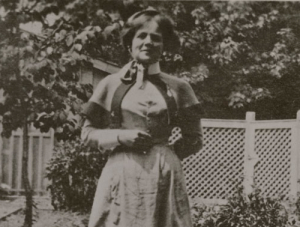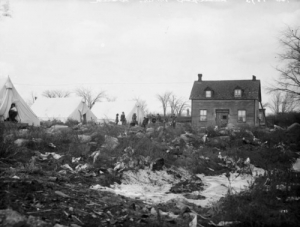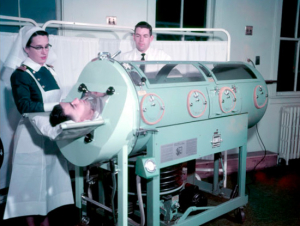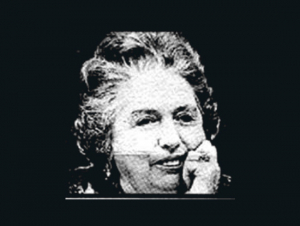The Ottawa Mission Past & Present
Our final speaker series session of 2023 was held via Zoom on the evening of November 29th. We were excited to welcome Peter Tilley as our guest to talk with us about The Ottawa Mission, its history, its role and the ongoing challenges that it and our community face. Given the housing and opioid crisis we are experiencing today, Peter’s presentation could not have been more timely.
Peter is the current CEO of The Ottawa Mission, having joined them in June 2013. Before this, he had spent 14 years as the Executive Director of the Ottawa Food Bank and has been a part-time professor at Algonquin College. Apart from this, Peter volunteers on community boards, including Ottawa Public Health, the Chair of the Ottawa Inner City Health and a Board member of the Alliance To End Homelessness and Soldiers Helping Soldiers as well as being a volunteer at Parkdale United Church. He is far more than an administrator, however, he takes the time to speak to shelter guests, lending them a friendly ear, and calling them by their first names.
Peter told us that there is a big safe in the basement of The Mission that contains a lot of their archives, including many old photos and ledgers. From these, he has been able to piece together the following history of The Ottawa Mission.
The Ottawa Mission can trace its origin to September 20, 1906 when a public meeting was held to discuss opening a shelter for homeless men camped along the Ottawa River. By January 1907, a shelter, The Union Mission for Men, had opened on George Street, moving to its current location on Waller Street in 1912. Peter provided some general context for the opening of the shelter in 1907, reminding us that at that date Canada had a population of 6.5 million of which over 50 % were rural, women and Indigenous people were not allowed to vote, life expectancy was 50 years and the population of Ottawa stood at 110,000. The first Superintendent of The Union Mission, James Joab, established its cornerstone principle by declaring that “No man would ever be turned away the first night they came to The Mission”.
Peter explained that the main focus of The Mission in those early days was “Three Hots and a Cot” (3 meals & a bed), which is still a key component of their services today. Peter shared a photo of the time, showing that the men were in suits with ties and their hats on their laps. Meals were then 10 cents, though you could get a voucher for a free meal. One of the first great challenges they faced was providing service to returning veterans of the First World War, many of whom were suffering from what was then called “shell shock” and what we now know as PTSD, broken men needing help.
On October 29, 1929, the “Roaring 20s” came to a “Roaring Halt” with the crash of the New York Stock Market and the resulting disruption of the world’s economies. Thousands of people lost their jobs and so had no income. This was reflected in the number of meals served by The Mission: in 1929, 73,000 but in 1932, 425,662. This was a time of constant struggle for the staff, with many appeals to the public, just to keep the doors open and stay true to their vow that no one would be turned away. Things were very basic, but they got through it.
Following the Second World War The Mission found that alcoholism was rampant among returning veterans suffering from PTSD. The Mission served as a refuge for those men who could only deal with the brutality of what they had experienced through a cycle of drink and sleep, before they passed on. Peter said that The Mission offered “Soap, Soup and Salvation”.
Canada experienced an economic boon from the 1950s through the 1970s, and The Mission continued to offer its services. It still supported those suffering with alcoholism, but found it was also providing a place for those who just needed a meal and a bed, and in some cases, Americans who had come north to avoid the draft for the war in Vietnam. By the late 1960s and into the 1970s, men dealing with drug addiction became a new population needing support.
Peter explained that by the mid-1980s the boom had ended and governments entered a period of cut-backs and downloading of services that had effects throughout the community. In particular, the Ontario government closed facilities such as Rideau Regional, that cared for individuals living with a variety of cognitive and emotional impairments, forcing many into the community without support. Peter explained that, under the leadership of Diane Morrison, the first female Director of The Mission, they grew by 60 beds in the mid-1990s to meet this new need.
The Pandemic hit The Mission hard. They transitioned some of their services, such as addiction and mental health counselling from in-person to virtual, handed out take-our meals to the community through their loading dock, delivered meals to others in the city through a food truck. Peter said that the staff team worked with little break and no vacation through the first 18 months of the pandemic to ensure that they continued to provide their services. The major projects they had planned were placed on hold and are only now being revived as the heaviest effects of the pandemic wane.
Peter shared a number of photos of The Ottawa Mission as it looks today, including images of the kitchen, dining hall, bedrooms, showers and one of the two apartment buildings they own and run as mixed-market rental buildings. The Ottawa Mission now has its own in-house maintenance team that takes care of its buildings, including the former Albert Inn, that is now the home for their Addiction Program and the former Rideau Bakery, which runs their Food Services training program.
Peter wrapped up his fantastic presentation by discussing the range of services now offered by The Ottawa Mission and the challenges they face. Today The Ottawa Mission offers a wide range of services. Although its overnight and addiction programs remain restricted to men, for reasons of safety, all of its other services are open to both men and women. These include: primary health care, mental health care, dental care, foot care, a wide range of education, job readiness and job training programs, housing support and a food truck program among others. Today, as well, the demand for these services is growing. With the opioid crisis, the housing shortage, the rapid rise in price of food and other necessities and the influx of refugees there is even greater pressure on The Mission and there staff than ever before.
The Ottawa Mission is “ALWAYS OPEN, NEVER CLOSED”, 24 / 7 every day of the year, for over 115 years, with over 1,000,000 hours of service to the most vulnerable in our community.
Its work must continue but for that to happen, they need your help. Only 25% of their funding comes from governments, the rest comes directly from members of the community. To volunteer or donate, please see The Ottawa Mission website.
To watch Peter’s full presentation, please see The Ottawa Mission: Supporting Our City's Most Vulnerable on the HSO YouTube channel.
Banish the Fly!
1 July 1912
The best way of getting rid of Mr. Fly is to get rid of his boarding house and his breeding house—the rubbish heaps, the old barrel, the exposed manure pile, or whatever is usually found in a neglected city back yard. Ottawa Journal, 1913.
Musca domestica, the pesky housefly. Easily identified by the four black stripes on its thorax, the housefly, which measures about 5 to 7 millimetres, in length, can be found throughout the world wherever humans live. Indeed, the housefly has made a “career” of feasting on the detritus of humans and their domesticated animals. After mating, the female of the species lays her eggs in batches of 100 or more on rotting vegetable or animal matter, including carrion or feces. After a day or so, the larvae hatch and begin feeding. They mature in as little as two weeks depending on temperature conditions. A female housefly can live for about a month and can produce as many as 500 eggs during her lifetime. In the absence of avian and insectile predators, as well as humans armed with rolled up newspapers, two amorous flies can produce a gazillion descendants during a summer. Thankfully, this is not the case.
While houseflies play an important ecological role in recycling organic wastes, their habit of feasting on the garbage in the bin at the side of the house, or the dog poop in the backyard, before skittering over granny’s lemon chiffon cake is not an endearing feature. Consequently, they have long been considered a vector for the spread of disease. Their persistence and apparent clairvoyance are other annoying behavioural features. Who hasn’t futilely tried to discourage a determined fly from walking all over one’s arms or legs?
Sustained efforts to rid cities of the much-hated housefly took place during the early years of the twentieth century in major Eastern US cities, such as Cleveland, as well as in major cities in Canada, including Toronto, Montreal, Hamilton, and Ottawa. The objective was to curb the spread of disease, particularly tuberculosis, typhoid, and infant diarrhea, believed to be spread by houseflies.
Such efforts had many elements. First, cities introduced bylaws requiring their citizens to take steps to minimize the breeding grounds of flies by collecting and covering manure piles. Recall the prevalence of horses during this period; cars had yet to replace them to any significant degree. As one horse can produce ten kilograms of manure daily, equine waste disposal was a major problem. Much was simply left on the streets, thereby attracting flies. Second, public health organizations distributed literature to households on the habits of houseflies, their impact on public health, and how to kill them or, barring that, keeping food uncontaminated and homes pest-free. Third, children, often the Boy Scouts, were mobilized to kill the bugs and to spread the word; the rationale being to harness youthful zeal, and to educate the next generation who might be more open that their parents to new health ideas. Recall that the germ theory of disease was still relatively new during the early twentieth century. Many people still thought bad smells, called miasmas, were the cause of disease. The idea that flies could transmit disease by just walking on food was a novel concept for many.
In July 1912, the Montreal Daily Star hosted a “Swat the Fly” contest in Montreal, offering prizes totally an amazing $350—a huge sum at that time, equivalent to close to $10,000 today—with first prize being $25. The contest was open to all children, both boys and girls. The contest was a huge success. Nearly one thousand Montreal children answered the call, swatting approximately 25 million flies, and, more importantly, spreading the word about household hygiene. Their tally, which far exceeded the paltry tally of 1.5 million flies caught by Toronto kids, as well as those of cities south of the border, earned Montreal the title of “world fly-swatting champion.”
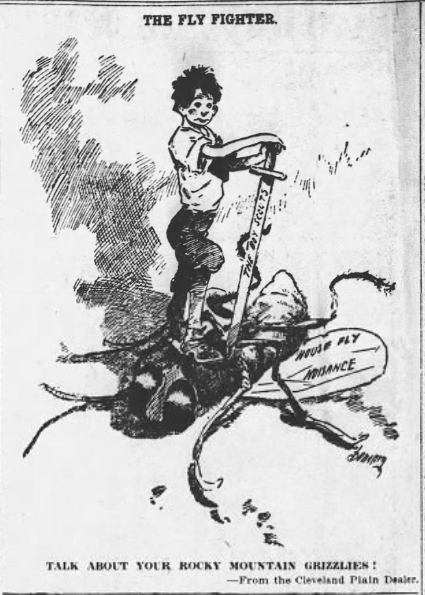 Ottawa Evening Citizen, 15 June 1912Ottawa also took up the anti-fly challenge. In May 1911, city council passed a bylaw requiring downtown stables to contain manure in bins with tight covers or to be connected to the sewers. At the time, the Ottawa Citizen estimated that as many as three-quarters of downtown stables were not doing this. As well, the enforcement of existing hygiene laws appears to have been lax owing to the cost of regular inspections. The newspaper opined that “the greatest single step towards the elimination of the house fly in Ottawa will be when all stable within the city limits whether by careful inspection, or otherwise, are compelled to follow the simple and easily kept rules which other cities have imposed thereon.”
Ottawa Evening Citizen, 15 June 1912Ottawa also took up the anti-fly challenge. In May 1911, city council passed a bylaw requiring downtown stables to contain manure in bins with tight covers or to be connected to the sewers. At the time, the Ottawa Citizen estimated that as many as three-quarters of downtown stables were not doing this. As well, the enforcement of existing hygiene laws appears to have been lax owing to the cost of regular inspections. The newspaper opined that “the greatest single step towards the elimination of the house fly in Ottawa will be when all stable within the city limits whether by careful inspection, or otherwise, are compelled to follow the simple and easily kept rules which other cities have imposed thereon.”
In June 1912, it was announced in the Ottawa Citizen that there would be an anti-fly contest in the nation’s capital running for two weeks beginning Dominion Day. Ottawa’s new slogan for the period was “Banish the Fly!” The contest was organized by the Public Health Committee of Ottawa’s local Council of Women in co-operation with the city’s department of health. The Council provided nine prizes with a total value of $25, with the event open to both boys and girls under fifteen years of age. The boy or girl killing the most houseflies would win $10, with second place earning $5. There were also three third-place prizes of $2 each and four fourth-place prizes of $1. Captured flies were to be turned over to the office of Dr. Shirreff, the city’s chief medical officer, at City Hall, for inspection and counting. Children could use any sort of container in which to bring their “catch.” Any method of fly-catching was acceptable except apparently for the use of “tanglefoot paper.” The newspaper said that the competition was “a new and vital form of educating people to a danger long overlooked or neglected,” and hoped that the campaign would get a good response so that “Ottawa will this summer be a most unpopular resort for the fly.” A similar “Swat the Fly” contest was also launched in Hull.
Consistent with doctors’ recommendations, the newspaper advised kids to catch flies outside before they had a chance to come inside and spread disease. Homeowners were told to equip all windows and doors with screens to keep out the pest, and to move rubbish and refuse away from back doors. The Citizen also recommended poison as the most efficacious means of killing flies. Helpfully, the newspaper provided recipes. The first was an innocuous mixture of the yolk of one egg, 1/3 cup of sweet milk, one level tablespoon of sugar, and one level tablespoon of pepper. Alternatively, it recommended a mixture of two tablespoons of formalin and 16 ounces of equal parts of water and milk. Regardless of the mixture used, the Citizen said that it should be placed in shallow plates, with a piece of bread floating in the middle to allow more room for the flies to land on. As a testimonial to the effectiveness of the formalin trap, it cited a Professor R. J. Smith of North Carolina who apparently caught 40,000 flies in a calf barn during a 16-hour period using the recipe.
One thing the newspaper neglected to mention, however, was the dangers of formalin. A lethal dose for an adult human is about 30 millilitres, the amount recommended by the newspaper in its fly poison recipe. Used for embalming purposes and in dilute amounts as an anti-bactericide, formalin, a colourless liquid, releases formaldehyde gas which is both flammable and poisonous. Dangerous to have around the house, and not something one would want children to handle, woe betide any thirsty household pet that might be attracted to the milk and bread mixture.
Despite the exhortations of the Citizen, the “Banish the Fly” contest got off to a slow start. More than a week into the campaign, only nine boys and one girl had entered. The city kept a running tally of each participant’s “kill” and issued receipts. Half way in, John Cooney of 138 Besserer Street was in the lead with a total of 20,000 flies out of a total of 46,500 turned into City Hall.
In case you were wondering, health department clerks didn’t laboriously count each fly. Instead, the flies, which were brought into city hall in bottles, envelopes, matchboxes, and even a talcum power can, were weighed. Their weight in grammes was then multiplied by 200 to get an approximate number of houseflies.
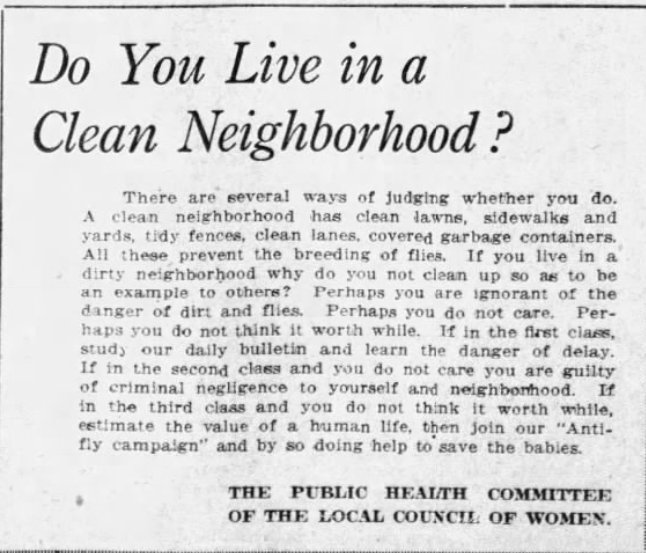 Public announcement, Public Health Committee of Ottawa’s Local Council of Women, Ottawa Citizen, 28 April 1915.Additional participants trickled in. By the close of the competition, twenty-two children—seventeen boys and five girls—brought a total of 458,300 flies to the Department of Health. In first place was eleven-year-old Roy Judd of 136 Besserer Street who had killed 61,700 flies. His preferred method was poison. In second place was Mortimer Thompson of 164 Hopewell Avenue. Ethel Moffat (age 12 years), of 143 Kent Street took the third position, and was the highest-scoring girl. John Cooney (age 10 years), who had been initially leading the competition came in fourth with 40,700 flies. John Cooney and Roy Judd, the ultimate winner, were next door neighbours. The youngest competitor was Clyde Swan of 201 Division Street (Bronson Avenue). The five-year old collected an impressive 7,600 flies.
Public announcement, Public Health Committee of Ottawa’s Local Council of Women, Ottawa Citizen, 28 April 1915.Additional participants trickled in. By the close of the competition, twenty-two children—seventeen boys and five girls—brought a total of 458,300 flies to the Department of Health. In first place was eleven-year-old Roy Judd of 136 Besserer Street who had killed 61,700 flies. His preferred method was poison. In second place was Mortimer Thompson of 164 Hopewell Avenue. Ethel Moffat (age 12 years), of 143 Kent Street took the third position, and was the highest-scoring girl. John Cooney (age 10 years), who had been initially leading the competition came in fourth with 40,700 flies. John Cooney and Roy Judd, the ultimate winner, were next door neighbours. The youngest competitor was Clyde Swan of 201 Division Street (Bronson Avenue). The five-year old collected an impressive 7,600 flies.
While anti-fly campaigns were launched in the years that followed, this was the only Banish the Fly contest held in Ottawa. Although the housefly population was barely dented, reviews were positive in that it helped to educate people about the relationship between public cleanliness and public health.
Whether the humble housefly deserved the opprobrium heaped upon it during the early twentieth century is less clear. According to Valarie Minell et al, the authors of Swatting Flies for Health: Children and Tuberculosis in Early Twentieth-Century Montreal, the housefly had been “vilified.” Indeed, today the house fly is generally viewed a nuisance rather than a major transmitter of disease. This probably reflects the fact that in urban areas there are now few horses and other forms of livestock, outhouses are a thing of the past, and kitchen waste is picked up weekly for composting. With fewer feeding grounds and hatcheries, housefly numbers are likely much smaller today than a hundred years ago. Nonetheless, Musca domestica is reportedly a carrier of hundreds of different forms of bacteria. Many of these bacteria are pathogenic to humans and can cause many diseases, including dysentery, tuberculosis, typhoid, and polio. To this long list, recent research has shown that the house fly can be a carrier of the bacteria H. pylori that can cause stomach ulcers.
So, the next time you spot a housefly, swat it.
Sources:
Khamesipour, F., Lankarani, K. B., Honarvar, B. & Kwenti, T. E., 2018. “A systemic review of human pathogens carried by the housefly (Musca domestica L.), BMC Public Health, Article No. 1049.
Minnell, Valerie. & Poutanen, Mary-Anne, “Swatting Flies for Health: Children and Tuberculosis in Early Twentieth-Century Montreal,” Urban History Review, Vol. 36, No.1 Fall 2007.
Ottawa Journal, 1911. “No Title,” 22 March.
——————-, 1911. “The Sanitary Inspection,” 12 June.
——————-, 1913. “One City Conquers Mr. Fly.
Ottawa Citizen, 1911. “Anti-Fly Bylaw,” 29 October.
——————, 1912. “Premium On Flies,” 7 June.
——————, 1912. “The Anti-Fly Campaign Gives Boys And Girls Chance To Earn Money,” 15 June.
——————, 1912. “Here He Is! Swat Him!” 1 July.
——————, 1912. “After Hull Flies,” 4 July.
——————, 1912. “Early Swatting,” 10 July.
——————, 1912. “An Educative Campaign,” 10 July.
——————, 1912. “Fly Campaign,” 11 July.
——————, 1912. “Fly Swatters Who Win Prizes,” 16 July.
Story written by James Powell, the author of the blog Today in Ottawa's History.
Retired from the Bank of Canada, James is the author or co-author of three books dealing with some aspect of Canadian history. These comprise: A History of the Canadian Dollar, 2005, Bank of Canada, The Bank of Canada of James Elliott Coyne: Challenges, Confrontation and Change,” 2009, Queen’s University Press, and with Jill Moxley, Faking It! A History of Counterfeiting in Canada, 2013, General Store Publishing House, Renfrew, Ontario. James is a Director of The Historical Society of Ottawa.
Victorian Order of Home Helpers, a.k.a. The VON
10 February 1897
By early 1897 Queen Victoria’s Diamond Jubilee was fast approaching. Across Canada, communities and governments were trying to decide on how best to mark this historic event. On 10 February 1897, a public meeting was held under the auspices of the National Council of Women of Canada in the assembly hall of the Normal School on Elgin Street to discuss a proposal to establish the Victorian Order of Home Helpers as a means of honouring the Queen’s long reign. This idea was consistent with the Queen’s wish that celebrations be connected with efforts to alleviate the suffering of the sick and poor. The Council’s president was the Countess of Aberdeen, the wife of the Governor General. Lady Aberdeen, born Ishbel Marie Marjoribanks, was a woman of extraordinary energy and ability. An early feminist, she had founded a number of charitable organizations in her native Scotland that focused on poor women. Following her husband’s appointment as Canada’s Governor General, she founded in 1894 the National Council of Women of Canada, and was the Council’s first president.
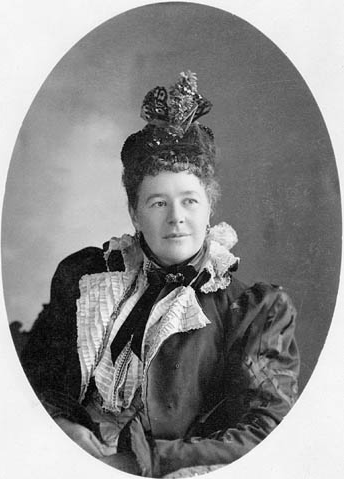 Lady Aberdeen, 1898, Library and Archives CanadaThe idea of a national organization of “Home Helpers” originated in western Canada, possibly at a meeting of the Vancouver local council of women and Lady Aberdeen. Another report suggested that the idea came from the local council of Victoria, and was later forwarded to the National Council of Women. Regardless, Lady Aberdeen was an early supporter and quickly became identified with the proposal.
Lady Aberdeen, 1898, Library and Archives CanadaThe idea of a national organization of “Home Helpers” originated in western Canada, possibly at a meeting of the Vancouver local council of women and Lady Aberdeen. Another report suggested that the idea came from the local council of Victoria, and was later forwarded to the National Council of Women. Regardless, Lady Aberdeen was an early supporter and quickly became identified with the proposal.
The public meeting at the Normal School was well attended. With the Governor General and senior government officials present, including the Premier, Wilfrid Laurier, Lady Aberdeen addressed the assembly. She stressed the debt owed by women to Queen Victoria—“no section of Her Majesty’s subjects have more cause to sing the praises of this glorious epoch than the members of Her Majesty’s own sex.” She noted that new possibilities had opened up for women during the Queen’s reign. The Queen has demonstrated that a woman can “have an intimate knowledge and grasp of the affairs of state whilst at the same time being a model of all womanly, wifely, and motherly virtues and charms.”
Speaking about the proposed scheme, Lady Aberdeen said Home Helpers would need to have a practical knowledge of midwifery, first aid, home-keeping, simple home sanitation, and the preparation of food for invalids. She thought that a “Home Helper” would be “constantly visiting homes in need—would be giving advice, cheering the home and doing various acts of mercy and kindness.” Successful applicants, who would have to pass an examination set by the medical profession, would be supplied with a uniform and the badge of the Order.
She estimated that $1 million was needed to ensure that funds would be available in perpetuity. Local women’s councils would undertake collections in co-operation with others. The Bank of Montreal agreed to receive subscriptions.
At the public meeting, Wilfrid Laurier, moved the following resolution, seconded by Clifford Sifton, the Minister of the Interior:
That this meeting heartily approves of the general character of the scheme described as the Victorian Order of Home Helpers as a mode of commemoration by the Dominion of the Queen’s Diamond Jubilee, and that a fund be opened for the carrying out thereof.
Despite governmental support, Lady’s Aberdeen’s Order of Home Helpers met mixed reviews, especially from members of the medical profession. Although doctors in Montreal, including Professor Craik, the dean of McGill’s medical school, supported the plan, it was rejected by others, including the Ontario Medical Association, as being impractical and even dangerous. Many feared that well-meaning but otherwise under-qualified women would be sent out to administer to the sick.
In part as a way to alleviate these concerns, the name of the scheme was quickly changed to the Victorian Order of Nurses (VON). The plan was also tweaked to make it clear that only highly-qualified nurses would qualify for the Order. The VON’s objectives were also clarified. They were: i) to provide skilled nurses in sparsely settled regions of the country; ii) to provide skilled nurses to attend sick poor people in their own homes; iii) to provide skilled nurses to attend cases in cities at fixed charges for persons of small incomes; iv) to provide cottage hospitals or small lying-in rooms in homes; and v) to train nurses to carry out these objectives. Nurse salaries, estimated at $400-500 per year, would be paid by the Order, with any fees collected by nurses from those who could afford them to be sent to the Order.
Despite these changes, opposition continued. Many doctors believed that it would be better if physicians and surgeons were paid bonuses to go out to frontier districts, or if funds were used to expand existing hospitals. Others doubted whether “even a very strong-minded female,” would be physically up to the rigours of a north-western winter if called out in the middle of the night.
Lady Aberdeen and other officials worked hard speaking to groups across the country to drum up support for the Victorian Order of Nurses and to dispel rumours that only minimally trained nurses would be hired. They also stressed that instead of replacing doctors, the nurses would, to the extent possible, be working under their direct supervision. This helped. In Winnipeg, the Manitoba Morning Free Press, which had been a fervent opponent to the scheme, was converted. Instead of believing that the Victorian Order of Nurses was “a well-meaning fad” that was “ill-digested, unwise and impractical,” as it had earlier opined, it concluded that “as the scheme becomes better known and its aim better understood, opposition and indifference will disappear.” The paper chided Winnipeg doctors for not attending a public meeting where details of the scheme were presented.
Some criticisms became very personal. The Halifax Herald attacked Lady Aberdeen. It wrote that the proper commemoration of Queen Victoria’s Jubilee was being “frustrated through Lady Aberdeen’s inability to mind her own business.” It was a “thoroughly quixotic scheme” and that “we expect our Governors-General to so govern their own families as to keep them out of mischief.” The New York Evening Post said that Lady Aberdeen was not popular in Canada, being “too clever and too advanced for Canadians.” Instead of paying attention to “etiquette and raiment,” she was “too much interested in ‘movements.’” Clearly the sight of an independent woman striving to make a difference in a male-dominated world was too much to stomach for some members of the public.
Given such criticisms, Lady Aberdeen must have received a much welcomed confidence boost when the British Medical Association and Lord Lister, the father of antisepsis, endorsed the Victorian Order of Nurses. She must have been similarly gratified when Florence Nightingale, the most famous nurse of all time, also came out in favour of her scheme.
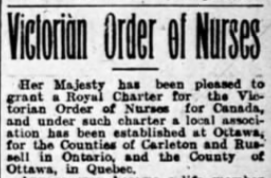 Newspaper clipping announcing the granting of a Royal Charter to the Victorian Order of Nurses, The Ottawa Evening Journal, 3 June 1898.Here in Ottawa, weekly meetings were held through the spring of 1897 in the Governor General’s office in the Departmental building on Parliament Hill to get the VON up and running. A provisional management committee was established, comprised of some high-powered people, including Lady Ritchie, the wife of Canada’s Chief Justice of the Supreme Court, the Bishop of Ottawa, and Sir Henri Joly de Lotbinière, a former premier of Quebec, later to become the Lieutenant Governor of British Columbia. Four trustees were also appointed to manage the money that began to flow to the Order. Sandford Fleming, a resident of Ottawa and the father of world-wide standard time, was one of the trustees. In late April 1897, the VON was officially endorsed by Ottawa citizens at another public meeting at the Normal School. The indefatigable Lady Aberdeen presided.
Newspaper clipping announcing the granting of a Royal Charter to the Victorian Order of Nurses, The Ottawa Evening Journal, 3 June 1898.Here in Ottawa, weekly meetings were held through the spring of 1897 in the Governor General’s office in the Departmental building on Parliament Hill to get the VON up and running. A provisional management committee was established, comprised of some high-powered people, including Lady Ritchie, the wife of Canada’s Chief Justice of the Supreme Court, the Bishop of Ottawa, and Sir Henri Joly de Lotbinière, a former premier of Quebec, later to become the Lieutenant Governor of British Columbia. Four trustees were also appointed to manage the money that began to flow to the Order. Sandford Fleming, a resident of Ottawa and the father of world-wide standard time, was one of the trustees. In late April 1897, the VON was officially endorsed by Ottawa citizens at another public meeting at the Normal School. The indefatigable Lady Aberdeen presided.
Slowly the money began to roll in. Subscriptions began at 5 cents. Both the great and small contributed. Sir Donald Smith (later Lord Strathcona and Mount Royal), the president of the Bank of Montreal and the man who hammered in the last spike on the Canadian Pacific Railway, donated $5,000, and pledged another $5,000 as soon as donations of $100,000 had been made by others contributing $1,000 or more. Meanwhile, fourteen children, the oldest aged 12, at a francophone school near Ottawa sent in their allowances. Their teacher attached a letter to Lady Aberdeen saying “The children of my school cannot pass this occasion to do something for Queen Victoria. Not being rich but having the will to aid the poor, they send you the amount enclosed.” The letter listed the names and ages of the children.
Although the scheme came nowhere near reaching the goal of $1 million, a huge sum back in those days, it received enough in donations and pledges, about $250,000, for it to proceed. On Jubilee Day, 22 June 1897, Lord Aberdeen, the Governor General officially announced the formation of the Victorian Order of Nurses as a lasting tribute to Queen Victoria.
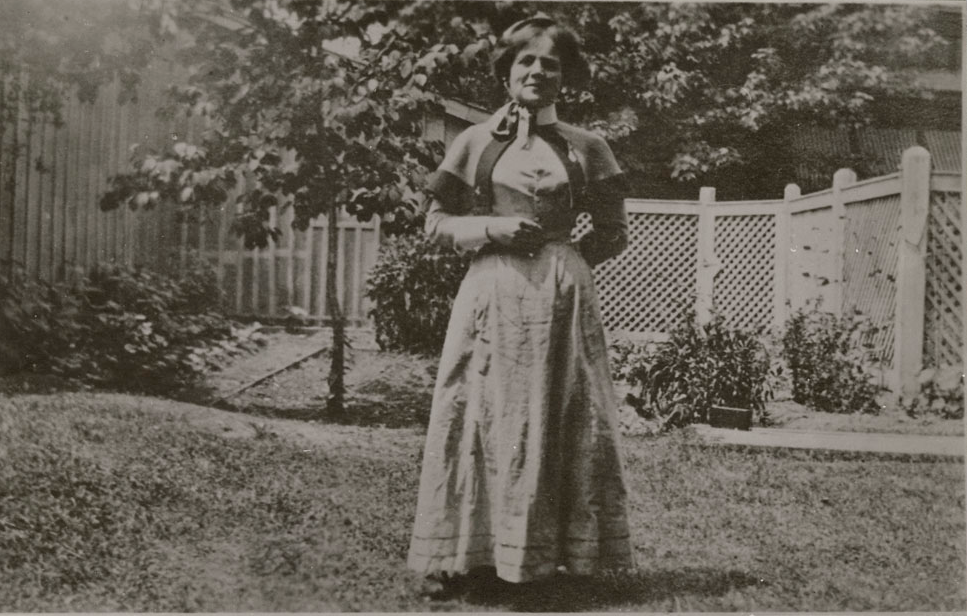 Miss Charlotte MacLeod, First Chief Superintendent of the Victorian Order of Nurses, 1898, Library and Archives Canada.
Miss Charlotte MacLeod, First Chief Superintendent of the Victorian Order of Nurses, 1898, Library and Archives Canada.
The VON hit the ground running. Within its first year, Lady Aberdeen had acquired the home of Alderman Davis of Ottawa at 578 Somerset Street for the Order’s headquarters. VON training homes were also established in Ottawa, Toronto, Montreal and Halifax. Miss Charlotte MacLeod, who had worked with Florence Nightingale, was named as the VON’s Chief Superintendent. In the spring of 1898, four nurses were sent to help administer to the sick in the Yukon. At this time, tens of thousands of people were travelling to the Klondike in the great gold rush. Disease, owing to poor sanitation, was rampant. Lady and Lord Aberdeen bid the nurses au revoir with a dinner at Rideau Hall on the eve of their departure on their month-long journey to Dawson City.
In early June 1898, it was announced that the Victorian Order of Nurses had received a Royal Charter for Canada as well as a local charter for an Ottawa chapter for the counties of Carleton and Russell in Ontario, and the country of Ottawa in Quebec. Life membership in the Ottawa chapter was set at $100, with an annual membership costing $5. Quickly, Ottawa had 18 life members and 40 annual members. A meeting was also held in the committee room of the Ottawa City Hall to elect a board of management. With the now Sir Sanford Fleming in the chair, an all-woman, twelve-person board was elected. Prominent among them were Lady Laurier and Lady Ritchie.
In late 1898, Lord Aberdeen’s tour of duty as Governor General came to an end. But before the vice-regal couple left Ottawa, Lady Aberdeen received a letter from Colonel Evens, the commandant of the Yukon military contingent expressing his and his soldiers’ “sincere appreciation” for the services of the Victorian Order nurses. “The work of the Victorian Order in Dawson is a great one, and the opening of the new hospital was providential. Their presence with the force has been invaluable…I don’t know how we should have fared without them.”
In 2017, one hundred years after its founding, the Victorian Order of Nurses had 5,000 employees and 9,000 volunteers, and provided 75 home care, support and community services in more than 1,200 Canadian communities.
Sources:
Halifax Herald (The), 1897. “A Halifax Opinion,” in The Ottawa Evening Journal, 25 May.
Manitoba Morning Free Press, 1897. “Victorian Nurses,” 23 April.
————————————-. 1897. “The Victorian Fund,” 28 May.
————————————-, 1897. “Victoria Order,” 28 May.
————————————-, 1897. “Order of Nurses,” 28 May.
————————————-, 1897. “Victorian Order Of Nurses,” 31 May.
————————————-, 1897. “The Victorian Order,” 2 June.
————————————, 1897. “The Victorian Order,” 7 June.
————————————, 1897. “The Doctors And The Victorian Order,” 8 June.
The New York Evening Post, 1897. “Victorian Order of Nurses,” in the Vancouver Daily World, 12 August.
Ottawa Evening Journal (The), 1897. “Victorian Home Helpers,” 11 February.
————————————-, 1897. “Some Explanations,” 3 March.
————————————-, 1897. “Getting Organized,” 19 March.
————————————-, 1897. “Citizens Will Meet,” 21 April.
————————————-, 1897. “Victorian Nurses,” 24 April.
————————————-, 1897. “Ottawa Is In Line,” 26 April.
————————————-, 1897. “Victorian Order of Nurses,” 14 June.
————————————-, 1897. “The Scheme Unpopular,” 13 July
————————————-, 1897. “Eager To Help, 20 July.
————————————-, 1898. “Klondike Nurses,” 28 March.
————————————-, 1898. “Music For Rideau Hall,” 31 May.
————————————-, 1898. “Victorian Order of Nurses,” 3 June.
————————————-, 1898. “Home For V.O.N.” 7 June.
————————————-, 1898. “Women’s Council,” 12 July.
————————————. 1898. “Victorian Nurses In The Klondike,” 1 October.
Vancouver Daily World, 1897. “Women Helpers,” 22 February.
—————————–, 1897. “Taking Practical Form,” 26 March.
—————————–, 1897. “Cablegram from Sir Donald Smith” 28 June 1897.
—————————–, 1897. “Victorian Order Of Nurses,” 1 October.
—————————–, 1898. “Training Home For Nurses,” 27 July.
VON Canada, 2017. http://www.von.ca/.
Story written by James Powell, the author of the blog Today in Ottawa's History.
Retired from the Bank of Canada, James is the author or co-author of three books dealing with some aspect of Canadian history. These comprise: A History of the Canadian Dollar, 2005, Bank of Canada, The Bank of Canada of James Elliott Coyne: Challenges, Confrontation and Change,” 2009, Queen’s University Press, and with Jill Moxley, Faking It! A History of Counterfeiting in Canada, 2013, General Store Publishing House, Renfrew, Ontario. James is a Director of The Historical Society of Ottawa.
Smallpox and the Porter Island Isolation Hospital
2 November 1893
Be thankful that you live today and not a hundred years ago. Then, communicable diseases were rampant. Diphtheria, measles, whooping cough, and scarlet fever routinely killed babies and infants. In 1909, the infant death rate in Ottawa was a horrific 283 out of 1,000 live births. (In 2017, the rate of infant mortality in Canada was 4.5 out of 1,000.) Even if you managed to survive the so-called “childhood diseases”, you ran the gauntlet of contracting other lethal illnesses such as cholera, tuberculosis, and typhoid. Epidemics periodically swept through the fetid cities of North America killing thousands. But of all the diseases, the one that people feared the most was smallpox.
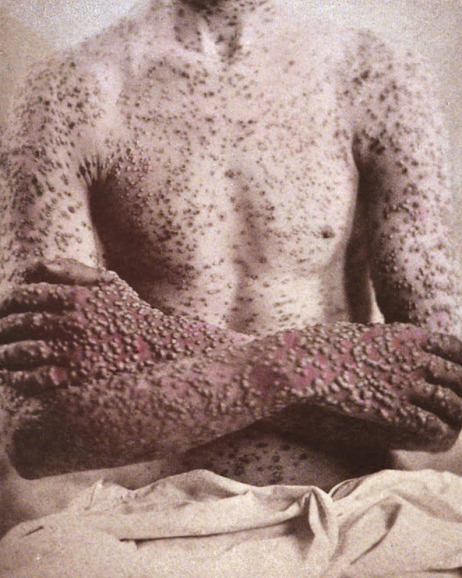 Smallpox sufferer, 1886, Fox, George Henry, Photographic Illustrations of Skin Diseases (2nd Edition), Wikipedia.Smallpox has a long history. There is some evidence that the disease was present in ancient Egypt more than three thousand years ago. More reliably, descriptions of the disease can be found in Chinese medical texts of the 4th century AD. It was prevalent in south-west Asia by the 10th century. By the thirteenth century, people in the Middle East were practising variolation to ward off the disease by inoculating people with the live virus—liquid from a smallpox pustule was rubbed into a scratch in the skin. This was a dangerous procedure, but it conferred life-long immunity.
Smallpox sufferer, 1886, Fox, George Henry, Photographic Illustrations of Skin Diseases (2nd Edition), Wikipedia.Smallpox has a long history. There is some evidence that the disease was present in ancient Egypt more than three thousand years ago. More reliably, descriptions of the disease can be found in Chinese medical texts of the 4th century AD. It was prevalent in south-west Asia by the 10th century. By the thirteenth century, people in the Middle East were practising variolation to ward off the disease by inoculating people with the live virus—liquid from a smallpox pustule was rubbed into a scratch in the skin. This was a dangerous procedure, but it conferred life-long immunity.
Smallpox is caused by the variola virus, and came in two forms: the virulent variola major strain, which had a death rate of about 30 percent, and the less severe but less common variola minor type that had a death rate of about 1 percent. The characteristic symptom of the disease was raised pustules that spread across the body, especially the extremities. Survivors of smallpox often experienced terrible disfigurement and blindness.
By the 15th century, the disease was well-established in Europe. Subsequently, European explorers and traders introduced smallpox to the Americas. Lacking resistance to the disease, Indigenous populations were virtually wiped out. The fall of the Aztec and Inca civilizations in South and Central America was due far more to smallpox than the weaponry of the Spanish conquistadors. In what was to become Canada, European settlers brought the disease to eastern First Nations. Later, the Plains tribes were infected through their interaction with voyageurs and traders. The result was calamitous. Whole communities died. In just one epidemic on the Prairies in the 1830s, two-thirds of the Blackfoot First Nation perished.
A major step towards conquering the disease occurred in 1796. Noticing that dairymaids who had contracted cowpox, a mild disease, appeared to be immune from smallpox, the British scientist Edward Jenner undertook an ethically-challenged experiment. First, he inoculated a young boy with cowpox serum. As expected, the child only experienced a slight fever, a few aches, and a temporary loss of appetite. Two months later, Jennings infected him with smallpox. Fortunately, the boy had no reaction; he was immune as Jennings had hypothesised.
Although several countries enthusiastically embraced vaccination (from the Latin word vacca meaning cow)—Bavaria reportedly introduced mandatory vaccination as early as 1807—it was a hard sell elsewhere. Like today, anti-vaxxers peddled “alternative facts” and received wide press coverage. To give the anti-vaxxers their due, unclean vaccination equipment and unsanitary conditions could cause serious infection in an era long before antibiotics. Vaccinations also didn’t confer lifelong immunity and had to be repeated. However, the risks of contracting smallpox far outweighed the possible side effects of vaccination. But out of ignorance and fear, people still hesitated to get vaccinated, and epidemics continued to claim thousands of lives and maim many more.
Smallpox arrived in Ottawa as early as 1828 with the Rideau Canal workmen. Colonel By apparently averted an epidemic by organizing a speedy vaccination campaign. Fortunately, the disease did not appear to be a major health risk until later in the century. In 1860, the Ottawa Daily Citizen reported that “smallpox and throat disorders [most likely diphtheria] were very general.” Fortunately, fatalities were comparatively rare. In 1871, an outbreak of smallpox was reported in Sandy Hill in the Stewart Street area. In a letter to the editor, “Pro Bono Publico” complained that “cow yards, hog pens, and dirty yards in such abundance as to originate, let alone the nurturing of, disease and pestilence.” Another article reported the unwillingness of civil service men to reclaim their laundry when their washerwoman came down with smallpox, necessitating them to buy new clothes.
Initially, smallpox victims were treated in isolation wards in the Protestant General Hospital located on Rideau Street. Later, such patients were segregated in an annex. In the mid-1870s, despite considerable neighbourhood opposition, the Sisters of Charity opened a second, Catholic, smallpox hospital at the rear of the Catholic cemetery in Sandy Hill. Both hospitals were extensively used in a major smallpox outbreak in 1879-1880. Mortuary statistics show that 219 died of smallpox in Ottawa during 1879. A further 97 died before the epidemic ended by the middle of the following year out of 230 additional cases of smallpox—a mortality rate of 42 percent. (Ottawa’s population at the time was only 27,000.)
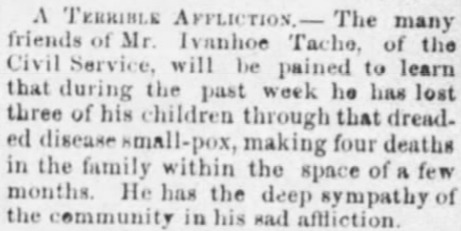 Announcement in the Ottawa Daily Citizen, 9 December 1879. All classes of people of all ages were affected by smallpox. The impact of the disease on families was devastating.When the Protestant Hospital was deemed “dangerous and unsuitable” as an isolation facility, the City began searching for another location for a new smallpox hospital. In 1893, City Council finally chose Porter’s Island, an eight-acre, low-lying property in the Rideau River.
Announcement in the Ottawa Daily Citizen, 9 December 1879. All classes of people of all ages were affected by smallpox. The impact of the disease on families was devastating.When the Protestant Hospital was deemed “dangerous and unsuitable” as an isolation facility, the City began searching for another location for a new smallpox hospital. In 1893, City Council finally chose Porter’s Island, an eight-acre, low-lying property in the Rideau River.
The major factors in favour of Porter’s Island were its relative isolation and price. Under provincial law, a smallpox hospital needed to be at least 450 yards away from inhabited areas. While a number of locations were considered, they were all deemed too expensive or not sufficiently accessible. A committee of city doctors also supported Porter’s Island on the grounds that the flowing water around the island lent itself to cleanliness. Others, however, worried that the damp, low-lying island was unhealthy, and that the island was prone to flooding. The Ottawa Clinical Society noted that there was a highwater mark nine feet above the mid-summer water level, indicating that up to a half of the island could be submerged during the spring freshet.
Despite these misgivings, the City awarded a contract for the construction of a cottage hospital on the island to Mr. John Bruce, the low bidder, for $16,400 on 2 November 1893. Construction commenced as soon as the City formally acquired the land, the price of which was settled through arbitration. (It was set later at $6,713, costs included.) Bruce promised to build three brick hospital buildings, which could accommodate some 100 patients, and a separate administration building. Another contract was awarded to Dominion Bridge Company to construct an iron bridge linking the island to St. Patrick Street for an additional $5,000.
Work on the isolation hospital was suspended three months later after the City had spent $34,000, and with the contractor demanding another $10,000 to complete the job. A local firm of architects, which inspected the site, found shoddy workmanship—the hospital’s foundation was built above the frost line, the brickwork was a third thinner than specified and was already cracking, and the floors were sagging. The next month, with the spring run-off underway, the basement of the administration building flooded just as critics had warned.
Then, the blame game began, with some City alderman saying “I told you so.” Others went into denial. One Island apologist said the situation was “not at all bad” other than a “few blemishes.” In April 1894, an official of the Ontario Board of Health visited Porter’s Island to assess the situation. His report dropped like a bombshell on City Council. He said the island was unfit for a hospital. He recommended against further expenditures on the island for hospital purposes, suggesting instead that the semi-constructed buildings be converted into an incinerator for garbage.
Over the next decade, City Council bickered over what to do with Porter’s Island, how they could re-coup the thousands of dollars spent, and whether the island could ever be used as the location for an isolation hospital. Nothing was resolved. Besides lawsuits, the only action taken was to fire G. F. Stalker, the project’s architect. He died of apoplexy shortly afterwards. Meanwhile, the semi-built hospital deteriorated owing to weather and theft despite the presence of a resident caretaker.
It wasn’t until 1902 that the administration of the Mayor Cook took the bull by the horns and built a new contagious disease hospital located on Regan’s Hill at the old Rifle Range in Sandy Hill (now the location of the Sandringham Apartments). Opening in 1903, the new Strathcona Hospital was designed to treat such diseases as diphtheria and scarlet fever—not smallpox which fortunately was in abeyance. Meanwhile, Porter’s Island was used as a refuse dump. Its derelict hospital buildings were demolished in 1904.
The need for a smallpox hospital returned with a vengeance when a serious smallpox epidemic swept the city in 1910-12. In response, the Ottawa Board of Health converted the caretaker’s frame house on Porter’s Island into a makeshift isolation hospital. When the numbers of smallpox victims rose beyond the capacity of the house, the City erected large tents on the island, notwithstanding it being the middle of an Ottawa winter. The tents were heated using “Quebec heaters” whose warmth extended only a short distance. There was no running water, no modern flush lavatories, and rats abounded, a situation made worse by the continued use of the island as a refuse dump. “Nothing is to be seen apart from the smallpox camp but tin cans, ashes, dead rats, decaying vegetables and fish,” said the Ottawa Evening Journal. Many exposed to smallpox hid in fear of being forced to Porter’s Island. Guards were stationed at the bridge to stop people escaping.
In May 1911, a naval architect and his five children were stricken with smallpox and ordered to Porter’s Island. The architect, an employee of the Public Works Department, reported to the Journal that vermin had eaten through eight military blankets on his bed located in one of the tents, which itself was sited just a few feet from a filthy outhouse. He managed to catch five rats using an improvised trap. Meanwhile his dying eight-year old daughter, who was conveyed to the Island in an ambulance that lacked basic amenities such as sheets and pillows, complained of abuse from one of the nurses. After the story broke, hospital staff said the man had exaggerated, saying he had only caught one rat. As for the charge of abuse, a nurse denied it. However, she admitted to occasionally slapping a child, after all “we had over thirty children at this Island and how could we make them behave and mind them all if we did not do this occasionally.” Remember that these children were in a frightening environment, many of whom were desperately sick, and had been separated from their parents.
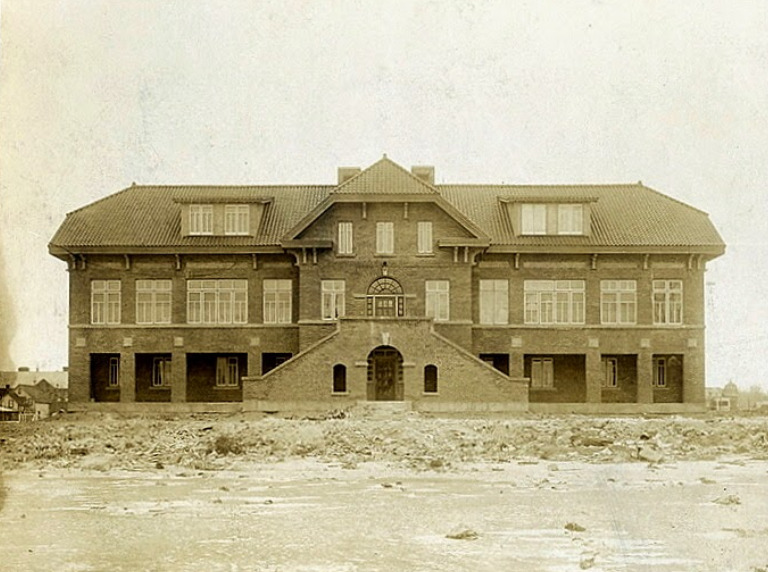 Hopewell Hospital, 1912, Alfred G. Pittaway, Bytown Museum, P893b.In November 1911, on a close 11-10 vote, with Mayor Hopewell casting the deciding ballot, City Council agreed to build a proper smallpox hospital on Porter’s Island. Architect Francis C. Sullivan was commissioned for the job. George A. Crain won the contract to build it at a cost of $30,323 which later rose to more than $45,000. To avoid being flooded in the spring, the 107’ x 37’ brick building was constructed on a raised fill platform. There was no basement. When the new Hopewell Hospital opened in late January 1913, the City burnt the old smallpox shack and tents.
Hopewell Hospital, 1912, Alfred G. Pittaway, Bytown Museum, P893b.In November 1911, on a close 11-10 vote, with Mayor Hopewell casting the deciding ballot, City Council agreed to build a proper smallpox hospital on Porter’s Island. Architect Francis C. Sullivan was commissioned for the job. George A. Crain won the contract to build it at a cost of $30,323 which later rose to more than $45,000. To avoid being flooded in the spring, the 107’ x 37’ brick building was constructed on a raised fill platform. There was no basement. When the new Hopewell Hospital opened in late January 1913, the City burnt the old smallpox shack and tents.
The last big epidemic to hit Ottawa occurred in 1920-1921 with more than 1,000 cases. Fortunately, the infecting strain was relatively mild. There were only two deaths. For a time, the Hopewell Hospital was completely full. At one point during the outbreak, more than eighty houses in Ottawa were also under quarantine. To interdict the disease at the border, the province of Quebec quarantined Ontario. Nobody could enter Quebec, including Quebec residents, from Ontario without an up-to-date smallpox vaccination certificate. Free vaccinations were given in the CPR station in Hull. By mid-year, the epidemic had been halted by a massive vaccination campaign with 40,000 vaccinations given out in Ottawa alone.
By the early 1930s, smallpox had become very rare, and was eradicated in Canada by 1946. With the underused Hopewell Hospital now obsolete, it was converted to apartments in the mid-1940s and demolished in 1967. Its site is currently occupied by the Chartwell Rockcliffe Retirement Residence. The old bridge constructed in 1894 is still standing although it is now closed to the public.
After a concerted global vaccination campaign carried out by the World Health Organization, smallpox was eradicated with the last naturally occurring case recorded in Somalia in 1977. The following year, a medical photographer caught the disease in a laboratory accident in Britain. She died. Currently, the only known smallpox virus stocks are held in the United States and Russia.
Selected Sources:
Fenner, F., Henderson, D. A., Arita, I., Jezek, Z., Ladnyi, I. D., 1988. “Smallpox and Its Eradication,” World Health Organization.
McIntyre John and Houston, C. Stuart, 1999. “Smallpox and its control in Canada,” CMAJ, 14 December.
Ottawa Daily Citizen (The, 1861. “Ottawa in 1860,” 4 January.
——————————-, 1871. “Sanitary Precautions,” 13 May.
——————————-, 1871. “The Effect of Small-Pox on the C.S.” 4 December.
——————————-, 1880. “Mortuary Returns,” 9 January.
——————————-, 1881. “The Health Of The City,” 12 January
——————————-, 1933. “Were Objections When Nuns Put Up Small-pox Hospital,”
Ottawa Evening Journal (The). 1893. “Board of Health Discuss,” 29 August.
————————————. 1893. “And Now For Porter’s Island,” 3 November.
————————————. 1893. “On To Porter’s Island.” 24 November.
————————————. 1893. “The Arbitrators Award,” 29 November.
————————————. 1894. “A Bolt Falls!” 24 Apri.
————————————, 1911. “Rats, Neglect And Filth Features Of A Sojourn On Porter’s Island,” 21 June.
————————————, 1911. “Heated Denials Made By Nurses Upon Island,” 22 June.
————————————, 1913. “Handsome Structure Erected By Famous C. Sullivan, A Young Ottawa Architect,” 8 February.
———————————–, 1920. “Quebec Quarantines Ontario On Account OF Smallpox,” 6 January.
———————————–, 1921. “The Smallpox Risk,” 27 January.
———————————–, 1921. “Smallpox Now Under Control,” 16 February.
Passfield, Robert W. 2013. Military Paternalism, Labour, and the Rideau Canal Project, Bloomington: AuthorHouse.
Riedel, Stefan, 2005. “Edward Jenner and the history of smallpox and vaccination,” Baylor University Medical Center Proceedings, 18 January.
Urbsite, 2014., http://urbsite.blogspot.com/2014/07/the-smallpox-hospital-porters-island.html.
Walker, Kate, 2015. “Medical Ottawa: Ottawa’s Smallpox Outbreak of 1911 And The Origins Of The Hopewell Isolation Hospital,” A Canadian Treasury of Medical History, http://canuckhm.ca/ottawas-smallpox-outbreak-of-1911-the-origins-of-the-hopewell-isolation-hospital/?doing_wp_cron=1552596495.2340080738067626953125.
Story written by James Powell, the author of the blog Today in Ottawa's History.
Retired from the Bank of Canada, James is the author or co-author of three books dealing with some aspect of Canadian history. These comprise: A History of the Canadian Dollar, 2005, Bank of Canada, The Bank of Canada of James Elliott Coyne: Challenges, Confrontation and Change,” 2009, Queen’s University Press, and with Jill Moxley, Faking It! A History of Counterfeiting in Canada, 2013, General Store Publishing House, Renfrew, Ontario. James is a Director of The Historical Society of Ottawa.
The End of the Crippler
18 April 1955
 Anti-Polio Advertisement,
Anti-Polio Advertisement,
The Ottawa Journal, 2 February 1950
Thanks to vaccines we no longer live in fear of many infectious diseases that used to stalk the world killing millions each year, and maiming or crippling tens of millions more. By the early 1950s, Canadian children were routinely immunized against smallpox, diphtheria, whooping cough and tetanus. But several diseases remained to be conquered. One of the most feared was poliomyelitis, also known as infantile paralysis for its propensity to affect the young, or “the Crippler.”
The disease is caused by the poliovirus, a type of enterovirus of the family Picornaviridae. It was first isolated in 1908 by the Austrian researchers and physicians Karl Landsteiner and Erwin Popper. The virus has three serotype versions (PV1-Brunhide, PV2-Lansing and PV3-Leon). All are virulent, though PV1-Brunhide is the most common strain, and the one most associated with paralysis. Most people who come into contact with the polio virus experience no symptoms beyond a sore throat, a gastrointestinal upset, a slight fever, and a general malaise. Called “abortive polio,” this is considered a minor illness that leaves no permanent effects. A small percentage of victims experience “aseptic” polio that also involves severe neck, back and muscle pain, as well as a bad fever. In a still smaller percentage of sufferers, the polio virus attacks the central nervous system leading to muscle flaccidity, especially of the limbs, and paralysis. Depending on what part of the nervous system is affected, “paralytic” polio is classified as spinal, bulbar, and bulbospinal. In some cases, the diaphragm and chest muscles are affected. Sufferers of this form of the disease need help to breath. In 1927, two Harvard researchers invented the “iron lung,” into which paralysed patients were placed to aid their breathing mechanically. Although most were able to leave the machine after several weeks, some were confined for years, or had to use a portable breathing apparatus. Polio suffers whose limbs had become paralyzed sometimes recovered their use after a few weeks. However, some many were left permanently disabled. Two to ten per cent of people stricken with paralytic polio died. There is no cure for the disease, only prevention.
Although polio has been around for thousands of years, it didn’t use to have the fearful reputation that it had during the first half of the twentieth century. For the most part, people had acquired a natural immunity to the disease. But as living standards and hygiene improved, the incidence of the disease paradoxically increased. The natural immunity that protected people had been weakened or lost. According to Christopher Rutty, a medical historian, fears about polio, heightened by publicity, were disproportionate to the risk of catching the paralytic form of the disease. But frightened parents told their children to “regard [polio] as a fierce monster” that was “more sinister than death itself.” The fact that people at the time didn’t understand the transmission mechanism of the disease (typically faecal-oral) made it all the scarier. You didn’t know what to do to protect yourself and your family. When outbreaks occurred, often during the summer months, health officials in epidemic areas closed cinemas, playgrounds, and delayed school openings. In Ottawa, when the federal government announced in 1950 that the water from the Rideau River would be temporarily diverted to allow for repairs near its outfall into the Ottawa River, residents of Sandy Hill, fearful of polio-infected flies that might breed in exposed marshes and refuse, lobbied for the repairs to be delayed until after the summer polio season.
People stricken with polio were sent to special isolation hospitals for a minimum of seven days required by provincial law. Their families were quarantined. Ottawa’s Strathcona Isolation Hospital was one of six designated centres for the treatment of polio in Ontario. The other centres were located in Toronto, Kingston, London, Hamilton and Windsor. The Strathcona Hospital’s “territory” ran from Pembroke to Morrisburg. In 1953, the old hospital was closed when a new East Lawn Pavilion with isolation facilities was opened at the Ottawa Civic Hospital. Seventeen patients were transferred from the Strathcona facility, including one in an iron lung. Although this was a time before provincial health insurance (OHIP), the care for polio victims was paid for by the provincial government. Later, following complaints by doctors that they couldn’t submit bills to well-to-to polio patients, the government modified the rules to allow doctors to charge wealthy patients. Poor patients continued to receive free care at teaching hospitals connected to universities.
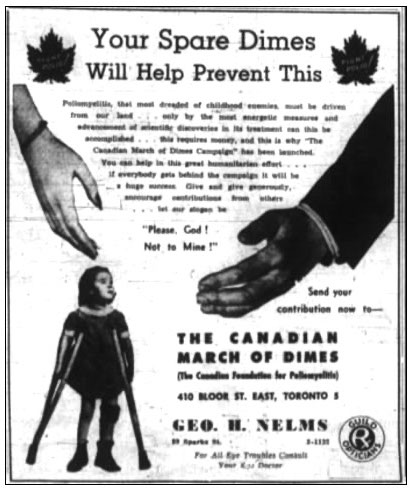 Advertisement for the Canadian March of Dimes, 1950 Campaign
Advertisement for the Canadian March of Dimes, 1950 Campaign
The Ottawa Journal, 4 February 1950Following the election of Franklin Roosevelt at President of the United States in 1933, who was himself a polio survivor, the medical profession in the United States and Canada took aim at the disease. Funding for research into the development of a vaccine was provided in the United States by the National Foundation for Infantile Paralysis that had its roots in a private anti-polio organization started by the Roosevelt family. The Foundation sponsored an annual March of Dimes campaign supported by Hollywood stars to raise money to find a cure for the disease and to care for polio victims. In Canada, a parallel organization called the Canadian Foundation for Poliomyelitis was founded in Ottawa in 1949. The Canadian Foundation held the first Canadian March of Dimes campaign the following year. Newspapers across the country carried the photograph of “Linda,” a child polio victim wearing iron leg braces. In Ottawa, twenty-five hundred blue and red checkered collection boxes were distributed in stores, banks and restaurants.
In 1953, North America experienced it worst outbreak of polio in decades. In Canada, there were 8,878 reported cases, mostly in Manitoba and Ontario, with a death rate of 3.3 persons per 100,000 population, far higher than during earlier outbreaks. Ottawa had 100 recorded cases by the end of that year’s polio season with four deaths. To help control the spread of the disease, Dr J. J. Dey, the city’s medical officer of health, advised Ottawa citizens not to drink unpasteurized milk, not to jump into water when the body was tired, and to avoid fatigue. He also told people to stay away from crowds, to keep the house free from flies, and to wash all fruits and vegetables. More usefully, he advised people to wash their hands frequently, and to boil drinking water if one had any doubts.
Fortunately, by this time, a vaccine was close at hand. In 1949, Harvard scientist Dr John Enders discovered that the polio virus could be propagated in the organs of monkeys. The following year, the Polish-born virologist Hilary Koprowski developed an experimental oral vaccine using a live but weakened virus of the PV2-Lansing variety of the disease, and successfully immunized some twenty children in New York State.
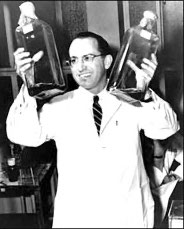 Jonas Salk at the University of Pittsburgh, 1955
Jonas Salk at the University of Pittsburgh, 1955
The Owl - University of Pittsburgh Digital Archives, WikipediaMeanwhile, at the University of Pittsburgh, Jonas Salk was working on determining the number of different strains of polioviruses and developing a vaccine using dead viruses that would be effective against all strains of the disease. Connaught Laboratories at the University of Toronto, supported by a federal grant as well as money provided by the Canadian March of Dimes, was also developing the procedure for producing industrial-size quantities of the polio virus, a necessary and vital step for the mass production of the Salk vaccine. Related work was conducted at the Institute of Microbiology and Hygiene in Montreal. Connaught later supplied much of the virus that went into making the Salk vaccine in North America as well as making the vaccine itself for the Canadian inoculation campaign.
By 1954, Salk who had safely tested his vaccine first on his family and then on 700 volunteers was ready for a large-scale test. He organized a trial involving two million children. Half received a three-shot dose of the experimental vaccine over a period of several weeks with the other half receiving placebos. Most of the children were American. But U.S. authorities offered 50,000 doses to Canada. Health departments in Alberta and Nova Scotia took up the offer and inoculated thousands of young children. In mid-April 1955, the results of the trial were announced to a packed conference room at the University of Michigan: polio had been defeated! The vaccine had been 80% effective in protecting children from the disease. The relief was palpable. Immediately, steps were taken to inoculate all children in North America starting with those in Grades 1 and 2.
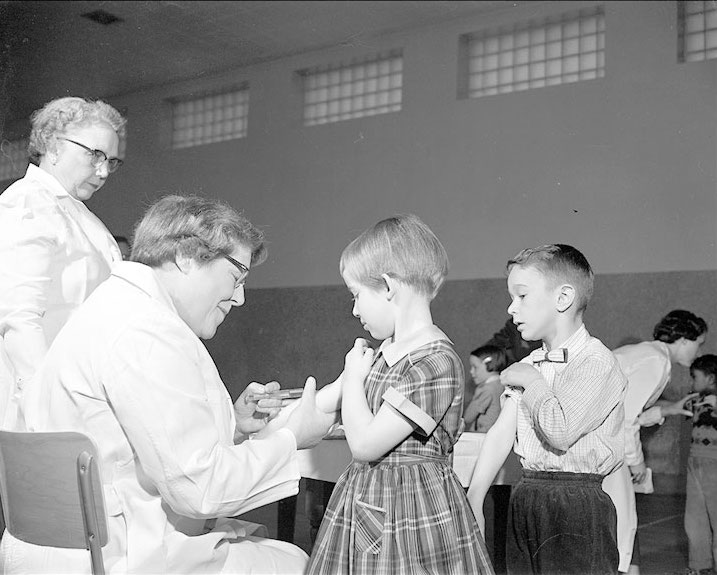 Polio shots at Elgin Street Public School, 1955
Polio shots at Elgin Street Public School, 1955
Newton Photographic Associates Ltd., City of Ottawa Archives, MG393-NP-36093-006, CA-025699In Canada, the inoculations were paid for on a 50:50 basis by the federal and provincial governments. Youngsters in Toronto and Pembroke received the first dose of the vaccine in early April even before the official announcement of Salk’s successful mass trial. The inoculation programme began in Ottawa on Monday, 18 April 1955. That morning, Grade 1 and 2 students at four public schools (Elgin, Lady Evelyn, Borden and Cambridge) and five separate schools (Ste Famille, St Patrick, St Jean Baptiste, St Anthony and Christ the King) received their first round of shots. That afternoon, five more schools were visited by teams of nurses. Children in remaining schools received their shots through the week. Parents had to sign a consent form for their children to receive the inoculation with the warning that if the children missed the first shot, they couldn’t receive the subsequent shots. Across the Ottawa River in Hull, the inoculation programme started in May with children aged two to three years since that age group had been most affected in Quebec during the 1953 epidemic.
In the midst of the roll-out of the continent-wide vaccination campaign, disaster struck. Some children in the United States came down with polio after having received their shots. Several died. The problem was traced to poor quality control at the Cutter Laboratories of Berkeley, California, one of six American vaccine manufacturers. Their vaccine contained live instead of dead viruses. According to the Journal of Pediatrics, the vaccine had been rushed. The U.S. vaccination programme was temporarily suspended despite the coming onset of the 1955 polio season. In Canada, Health Minister Paul Martin Sr faced one of the toughest decisions of his life: should the Canadian programme also be suspended as Prime Minister St Laurent wished? With all of the Canadian vaccine produced at Toronto’s Connaught Laboratories, and having full confidence in Canadian scientists and doctors, he ordered the Canadian programme to go ahead as planned. No Canadian child came down with polio as result of the vaccine.
By August 1955, the number of polio cases in Canada and the United States had dropped dramatically even though only a portion of children had been immunized. In November, Paul Martin publicly stated “I don’t think there can be any doubt that it [the vaccine] has had some effect.” By 1962, the number of reported polio cases in Canada had fallen to only 89.
In the early 1960s, the Salk vaccine was generally replaced by an oral vaccine using live but weakened viruses developed by Albert Sabin who drew on the earlier work of Hilary Koprowski. The Sabin vaccine was cheap to produce and administer and was very powerful—95 per cent effective after three doses (one for each polio strain). Polio infection rates around the world plummeted. In 1988, the World Health Organization (WHO) launched a campaign to eradicated polio from the world supported by national governments, the U.S. Centers for Disease Control and Prevention, UNICEF, Rotary International and the Bill & Melinda Gates Foundation. In 2000, the Americas were certified as polio free. In 2014, South-East Asia was certified as polio free. By 2016, the number of reported polio cases worldwide had dropped to only 37 located in Nigeria, Afghanistan and Pakistan. The WHO estimates that because of the global vaccination campaign, 16 million people walk today who otherwise would have been paralyzed. Many, many lives have also been saved. However, war and civil strife threaten this achievement. Endemic transmission of the disease continues in the three remaining polio hotspots. With vaccination efforts disrupted in these areas, the Crippler could well return.
Sources:
CBC Archives, 1993. A History of Polio in Canada, posted 7 April 2016.
Centers for Disease Control and Prevention, 2014, Poliomyelitis.
Council Bluffs Nonpareil (Iowa), 1954. “Report Results of Polio Research,” 11 April.
MedicineNet.com. 2017. Medical Definition of Abortive Polio.
Museum of Health Care at Kingston, 2017, Polio.
Ottawa Journal (The), 1949. “First Fatal Polio Case,” 20 July.
————————–, 1949. “Ottawa Cases of Polio Total 29 This Year,” 15 August.
————————–, 1949. “Foundation Plans Drive For Funds to Fight Polio,” 4 November.
————————–, 1950. “Rideau Draining To Proceed,” 10 August.
————————–, 1950. “St. Germain’s Protest Against Rideau Draining,” 15 August.
————————–, 1950. “March of Dimes For Polio Victims Starts Sunday,” 30 December.
————————–, 1953. “Ontario Announces new Policy For Treating Polio,”6 January.
————————–, 1953. “MOH Issues Statement on Polio,” 17 July.
————————–, 1953. “Lab Producing Polio Virus In Quantities,” 25 September.
————————–, 1953. “Polio Season Is Over,” 14 October.
————————–, 1953. “Hope-Filled Polio Vaccine For Million U.S. Children,” 17 November.
————————–, 1953. “New East Lawn Pavilion Opened At Civic,” 16 December
————————–, 1954. “Provinces Offered U.S. Polio Vaccine,”26 May.
————————–, 1955. “Polio Shots April 18 For Ottawa Children,” 4 March.
————————–, 1955. “Ottawa Will Start Trials of Polio Vaccine April 18,” 9 April.
————————–, 1955. “SALK CONQUERS POLIO,” 12 April.
————————–, 1955. “Salk Was So Confident of Success His Own Children Got Vaccine First,” 12 April.
————————–, 1955. “Ontario to Provide Injections for All School Children,” 12 April.
————————–, 1955. “Man’s Victory Over Polio,” 13 April.
————————–, 1955. “Duplessis Decides Quebec To Take Part In Anti-Polio Plan,” 15 April.
————————-, 1955. “First Week of Vaccine Shots Against Polio Start Monday,” 16 April.
————————–, 1955. “Salk Answers Critical Questions,” 7 June.
————————–, 1955. “Vaccine Producer Sued After boy Contracts Polio,” 24 June.
————————–, 1955. “U.S.A. ‘Polio Vaccine Mixup,’” 27 July.
————————–, 1955. “Big Drop In Deaths By Polio,” 12 August.
————————–, 1955. “U.S. Polio Fatalities Reduced Sharply,” 12 August.
————————–, 1955. “Martin Credits Salk Vaccine,” 1 November.
Rutty, Christopher, 1995. “Do Something!…Anything! Poliomyelitis in Canada, 1927-1962”.
———————-, 1999. The Middle-Class Plague: Epidemic Polio and the Canadian State, 1936-37.
Smithsonian, National Museum of American History, 2017. The Iron Lung and Other Equipment.
World Health Organization, 2017. Poliomyeliti.
Story written by James Powell, the author of the blog Today in Ottawa's History.
Eastview Birth Control Trial
17 March 1937
Birth control is an accepted part of modern life by all except the most religiously conservative. Competing brands of condoms in garish packages jostle for attention on the druggist’s shelves, while contraceptive pills, easily obtained by prescription, are covered by health insurance plans. It might therefore come as a surprise to learn that as recent as 1969 contraceptives were illegal in Canada. Even the dissemination of basic information about birth control was prohibited unless it could be shown to be “in the public good.” One of the big steps along the long road to repealing the law took place in Ottawa in the 1930s. However, the landmark legal decision that set change in motion had little to do with a woman’s right to control her body. Far more important were efforts to control the size of Canada’s poorer classes.
On 14 September 1936, Dorothea Palmer was arrested after visiting a welfare mother in the community of Eastview, now called Vanier. A week before her arrest, Palmer, who had received some training as a nurse in her native Britain before immigrating to Canada in 1928, had taken a part-time job in Ottawa with the Parents’ Information Bureau (PIB). The PIB, started in 1930 by Alvin Ratz Kaufman, a wealthy, Kitchener-based industrialist and philanthropist, provided poor families with pamphlets about birth control, as well as sample contraceptives. PIB workers would make house calls on poor mothers, typically by referral of a doctor or friend. After a mother filled out an application form, which asked a slew of questions, including her race, the number of pregnancies she had had, her husband’s occupation and salary, she could acquire contraceptives through mail order from the PIB for a small fee, or for free, if she were destitute.
Palmer was arrested by Constable Emil Martel and brought to the police station where she was questioned by Chief Richard Mannion. Believing she was not going to be charged, Palmer freely told the police what she was doing in Eastview, adding that “A woman should be master of her own body.” Mannion called the Crown Attorney who charged her with three counts under Section 207(c) of the 1892 Criminal Code for selling, advertising, and disposing of contraceptives. Although Palmer figured she would get in trouble with the Catholic Church, she was surprised to have been arrested. PIB workers had been told that what they were doing was legal as their actions were covered by the “public good” clause of the Act. However, the broad applicability of the clause, which was intended to protect doctors, was untested in court. Eager to set a legal precedent, Kaufman provided the $500 bail for Palmer’s release, and paid $25,000 for a top-rate legal team for her defence.
The trial, one of the longest in Canadian history, lasted six months. Witnesses, included social workers, clergy, and doctors, as well as twenty-one poor, francophone women visited by Palmer in Eastview. Judge Lester Clayton quickly dismissed two charges against Palmer, those of selling and disposing of contraceptives devices, due to lack of evidence, leaving the trial focused on whether or not the distribution of pamphlets on birth control fell under the “public good” clause of the Act.
The prosecution relied on medical opinions to show that birth control was unnatural, or dangerous, and that the distribution of birth control literature by lay people was not in the public interest. One obstetrician-gynaecologist called by the Crown argued that the control of a woman’s organs was above man’s law, and that birth control would lead to a woman experiencing “pathological conditions.” Another, a professor of gynaecology at the University of Montreal, spoke against all forms of birth control other than the rhythm method. On cross examination, he admitted that his objection was religious. Some doctors, while supporting birth control for existing mothers who wanted to space future pregnancies, argued that it should be handled solely by medical professionals. However, the testimony of medical experts was undermined when they acknowledged that they actually knew little about birth control; the subject was not taught in medical school.
Palmer’s defence team focus its arguments on the supposed sociological and economic virtues of birth control rather than human rights. Although the directors, both women, of the Toronto and Hamilton birth control clinics spoke about a woman’s reproductive rights, and the welfare of mothers, as did the Eastview mothers who didn’t want more children, their testimony was overshadowed by eugenic views expressed by male witnesses.
Prior to World War II, eugenics was a respected scientific theory, based on Darwinism, that aimed to improve mankind through selective breeding for beneficial human characteristics (positive eugenics) and the discouragement of negative traits through birth control or sterilization (negative eugenics). The Eugenics Society of Canada, established in the early 1930s, lobbied for the establishment of a national policy of “race betterment” by enacting legislation to “safeguard racial progress.” Many respected progressive Canadians were eugenics supporters, including Tommy Douglas and Nellie McClung. Both Alberta and British Columbia enacted legislation permitting the sterilization of unfit and feeble-minded individuals that wasn’t repealed until the early 1970s. Unfortunately, the terms “unfit,” and “feeble-minded” were open for interpretation. For many, racial improvement meant advancing the white, Anglo-Saxon, protestant “race” at the expense of others. Eugenics supporters also argued that the upper and middle classes were being outbred by the poor and mentally ill, leading to genetic, social, and economic disaster. To correct the birth differential, birth control should be made available to the masses. The reputation of eugenics crashed during World War II when Nazi Germany used the theory as justification for its racial policies that led to the death of millions in its concentration camps.
A number of prominent Canadian eugenicists testified at Palmer’ trial, including Alvin Kaufman, Treasurer and founding member of the Eugenics Society of Canada, Dr. William Hutton, the Society’s president as well as the Brantford Medical Doctor of Health, and the Reverend Dr. C.E. Silox, the Secretary General of the Social Service Council of Canada. Both Kaufman and Silox testified that since poor, unemployed workers were having large families, the only alternative to birth control was revolution or communism. Silox raised the Malthusian spectre of uncontrolled population growth requiring state intervention, or the “invention of new deadly diseases, more terrible famines, and bigger and better wars” to stop it. If that wasn’t controversial enough, Silox argued that French Canadians were deliberately outbreeding English Canadians while driving down their standard of living. By giving poor francophone families access to birth control, he claimed that Anglo-French tensions would be eliminated, and English dominance maintained. Le Droit, Ottawa’s French language newspaper, angrily retorted that the trial was all about killing French Canadians in the womb.
Dr. William Hutton presented dubious statistics purporting to show that the average intelligence of Canadians was declining due to a higher fertility rate of the less intelligent, a view supported by a University of Toronto psychiatrist who argued that Canada faced a biological crisis as a consequence. Further testimony by a Toronto economist underscored the burden to society of supporting the unemployed of Eastview, noting that the community’s unemployment rate was more than double the national average, and that births in the town outnumbered deaths by more than 150 per year. Similarly, the Secretary of the Toronto District Labour Council argued that birth control should be used to “govern the level of the nation’s population” until surplus workers were absorbed, or the economic system changed.
On 17 March 1937, Judge Clayton, swayed by the economic and social arguments made by the defence, ruled that Dorothea Palmer’s actions were indeed in the public interest. In his summing up, there was no mention of women’s rights. With the subsequent appeal by the Crown dismissed, Clayton’s ruling opened the door a crack for birth control in Canada.
Sadly, for all her courage, Palmer received little support from her husband, relatives and Church who disapproved of her stand. During her trial, a stranger, passing on the street, slapped her face. Palmer received obscene phone calls at all hours, and was sexually assaulted by a man who told her “I’ll show you what it’s like without any birth control.” Fortunately, a knee in the groin and a punch in the face stopped her assailant. After the trial, she quit the PIB, saying her work was done, and faded into obscurity. Palmer, a pioneer for women’s rights, died in 1992.
Sources:
Annau, Catherine, 1994. “Eager Eugenicists: A Reprisal of the Birth Control Society of Hamilton,” Social History, Volume XXVII, Number 53, p. 111-133.
Bonikowsky, Laura, 2011, “It’s About Control: Dorothea Palmer and Contraception,” Historica Canada Blog, 13 September.
Dodd, Dianne, 1983, “The Canadian Birth Control Movement on Trial, 1936-37,” Social History, Volume XVI, Number 32, p. 411-28.
Jasmin, Olivier, 2012. Eugenics in Canada.
Martel, Marcel, 2014, Canada The Good, A Short History of Vice since 1500, Wilfrid Laurier University Press, Waterloo.
National Post, 2012. “Canadians airbrush the truth Tommy Douglas’s enthusiasm for eugenics: MD,” 14 March.
Revie, Linda, 2006. “More Than Just Boots! The Eugenic and Commercial Concerns behind A. R. Kaufman’s Birth Controlling Activities,” Canadian Bulletin of Mental Health, Volume 23:1, p. 119-143, file:///C:/Users/User/Downloads/1269-1271-1-PB.pdf.
The Globe, 1936. “Palmer acquitted on one birth control count,” 21 October.
—————, 1936. “Public Good, Is Defense Point in Palmer Case,” 2 November.
—————, 1936. “Birth Control or Red Regime, Pastor States,” 3 November.
—————, 1936. “Rabbi, Pastors, Doctor Defend Birth Control,” 6 November.
—————, 1937. “Deny Charge of Obscenity,” 2 February.
The Globe and Mail, 1937. “Birth Control Case Dismissed,” 18 March.
———————–, 1978. “Did Dirty Work for men at trial, pioneer of birth control says,” 30 November.
Image: http://www.intlawgrrls.com/2010/09/on-september-14.html.
Story written by James Powell, the author of the blog Today in Ottawa's History.
Retired from the Bank of Canada, James is the author or co-author of three books dealing with some aspect of Canadian history. These comprise: A History of the Canadian Dollar, 2005, Bank of Canada, The Bank of Canada of James Elliott Coyne: Challenges, Confrontation and Change,” 2009, Queen’s University Press, and with Jill Moxley, Faking It! A History of Counterfeiting in Canada, 2013, General Store Publishing House, Renfrew, Ontario. James is a Director of The Historical Society of Ottawa.





